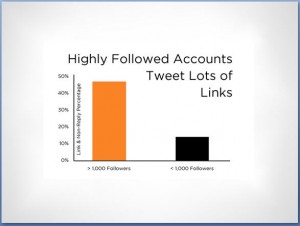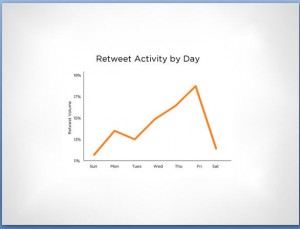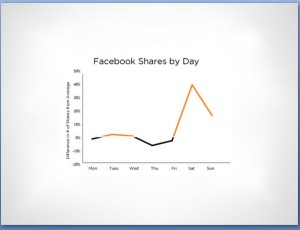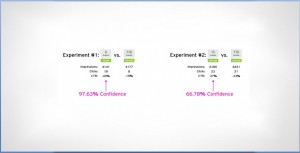Along with 45,000-plus attendees, I’m at Dreamforce ’11 in San Francisco this week as a guest of HubSpot. On Wednesday afternoon, I caught a session by Dan Zarrella of HubSpot about “engineering contagious ideas” using social media. You may be familiar with Dan from his personal website, his very popular HubSpot webinar series (including the recent Guinness Book recognized largest webinar ever) or his books such as the recently published, “Zarrella’s Hierarchy of Contagiousness.”
Dan’s talk at Dreamforce was based on his new book and his hierarchy of contagiousness:
- Exposure
- Attention
- Motivation
He broke down each of the three areas with a series of “best practices” myths, and presented the reality based on his research using publicly available information, or metrics on his own online real estate.
For this post I’m pulling one example from each of Dan’s hierarchy zones.
Exposure
The myth: “engaging in the conversation” is the most important thing in social media.
Essentially, the idea is that before you can join the conversation and get your ideas spread, people have to be exposed to your ideas. The way to accomplish this is to have a large Twitter following, have many “likes” for your Facebook page and a large opted-in email list.
How can you increase your exposure? One way is to regularly tweet quality links:

Dan’s takeaway from this is, “Engaging in the conversation doesn’t work, but publishing interesting content does.”
And also, influencers exist, but they’re not always who you expect. Getting a large social media following increases your exposure, and the likelihood you’ll reach an influencer who will help spread your message.
Attention
You may have the exposure numbers, but your social followers are hit with a huge amount of ideas each day. They don’t see every tweet that passes through their timeline, read every post on their Facebook wall or open every email they receive. You want to cut that clutter.
To do that, Dan’s research busts the myth of, “Friday, Saturday and Sunday are bad days to publish.”
Here’s Twitter:

And Facebook:

As you can see, retweets on Twitter spike on Friday and Facebook shares spike on Saturday.
Dan’s takeaway? “Use contra-competitive timing.”
If you want a message shared on social media, the weekend is a good time to put it out there. He speculated that one reason was there are fewer stories out on the weekend to distract readers and compete with your message.
Motivation
The exposure numbers are in place, you actually grabbed the attention of your audience, now they need to be motivated enough to actually share your message.
Dan said one thing that motivates people is scarcity. How many times have you read a blog post and found the initial comment is simply, “first!” The response might not be all that useful, but the scarcity of that top spot motived at least one audience member to take the time and add a comment.
To test scarcity, Dan used his own blog and manually tweaked the tweet counter. Here’s the results:

Let’s throw out experiment #2 and which did not result in a statistically significant difference between the variables tested at a high confidence level, but take a look at experiment #1 where there was a significant difference. When Dan’s readers thought no one had tweeted the blog post compared to 776 tweets, the relative difference in clickthrough rate was 127%.
I doubt that Dan thinks you should artificially create the illusion of scarcity (unless, of course, you’re running a test of your own), but his takeaway from this experiment is, “information is valuable when it is scarce.”
Related Resources
Headbanging with Hubspot, social networking with Salesforce
Marketing Testing and Optimization: The value of being wrong
Social Media Chart: Which channels are the most effective for inbound marketing?




1. The content of the article is not what was promised in the title. You know what I am talking about. Nice trick, but disappointing too.
2. The purpose of the post is clear, but the book seems to be really interesting, so there is no need in that ‘nice trick’ I believe. 🙂
3. I believe exposure and attention is the most difficult to reach. But once the first two are achieved, you need to strive your best to be good at the third.
Helen,
I’m sorry you feel that way, in regards to your first point. But I’m left scratching my head a little. The last thing we want to do is trick for the click with a title that we don’t deliver on. What’s the point of doing that? You’d find out in mere seconds and bounce anyway.
But please show me where you think we were off. In creating the headline, to me, it seemed that Dan was trying to optimize social media, the first part of the title, and was doing that by engineering the way he presented ideas in the hopes of making them contagious, or viral.
Hope I’m not being defensive, or overly dense, but I truly am lost on this one. Any help is appreciated.
This post is a great summary of a webinar session by Dan Zarrella of HubSpot.
The biggest take away for me is to post quality links to useful content. This strategy kind of reinforce my thoughts all along that to make your twitter strategy successful, you need to create remarkable content or know where to find remarkable content and then share it on your social media channels!
@Daniel Burstein I guess I have to say ‘sorry’ too. I guess I was too preconceived because, when I saw the title. I thought it would be an article about ‘Social Media Optimization’ but not about a book. You know people see what they want to see and that was the case with the article its title and how I read it. 🙂 My actions are too spontaneous sometimes.